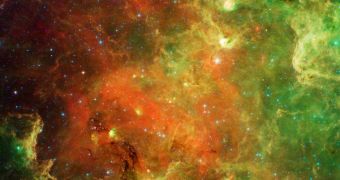Experts with the American space agency just published a new image of the North American Nebula, which shows a very large number of stars living together as one big, happy family. Most stellar types are present in the view, which was captured using the infrared NASA Spitzer Space Telescope.
The stellar nursery got its name because it resembles the said continent when viewed in visible-light wavelengths. The most interesting similarity is the Gulf of Mexico, which appears just as it does on a map of the Earth.
But the view changes entirely when the formation is viewed in infrared wavelengths such as those where Spitzer operates. The North American continent disappears entirely, and massive molecular clouds in the process of forming stars are revealed.
The clouds are mostly made out of cosmic dust and hydrogen gas. They are slowly accumulating around centers of gravity, and then collapse under their own weight. In the process, they ignite and begin nuclear fusion, therefore transforming into young, blue stars.
In the Spitzer view, the North American Nebula (NAN) exhibits all sorts of types of stars, including protostars, young stellar objects, medium-aged stars and older ones. All of them are sharing the same nursery, the team behind the new investigation reveals.
“One of the things that makes me so excited about this image is how different it is from the visible image, and how much more we can see in the infrared than in the visible,” explains Luisa Rebull.
“The Spitzer image reveals a wealth of detail about the dust and the young stars here,” adds the expert, who works at the NASA Spitzer Science Center (SSC), at the California Institute of Technology (Caltech), in Pasadena.
Rebull is also the lead author of a new paper detailing the findings. The work has already been accepted for publication in an upcoming issue of the Astrophysical Journal Supplement Series, JPL experts say.
“This is a really busy area to image, with stars everywhere, from the North American complex itself, as well as in front of and behind the region,” the SSC investigator says.
“We refer to the stars that are not associated with the region as contamination. With Spitzer, we can easily sort this contamination out and clearly distinguish between the young stars in the complex and the older ones that are unrelated,” she concludes.

 14 DAY TRIAL //
14 DAY TRIAL //